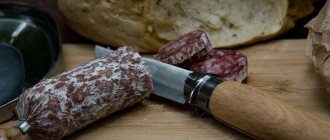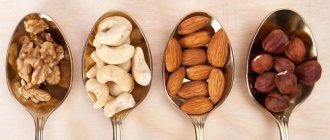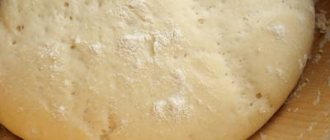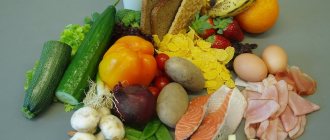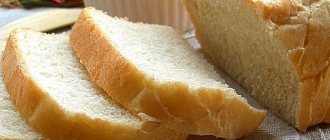Wheat bread made from 1st grade flour (GOST 26987-86.)
trablin
Good afternoon! You know, my friends, I am probably the only 30-year-old child in my generation. I’m ready to play a war game, build huts, live all summer at the dacha with my grandmother and ride on cement sacks along the dump mountains (a dump is the slag used to fill railway tracks). I admit the idea that I am not a romantic yearning for a bygone childhood or even youth, but simply an idiot.
I don't care. I love to light a fire and bake potatoes in the ashes, prick bread on a twig and fry it over the fire, so that later, sprinkled with gray pickling salt, I can eat it with a crunch, burning myself, joyfully squinting at the flames of the fire.
What I remember from the eighties.
The death of Chernenko, pineapples and bananas, in the absence of potatoes for sale, coupons, tangerines for the New Year, Gorbachev with his consensus and offer of something corner
hit, there was a line at the bread store, where my grandfather and I were numbered four hundred and we walked together, because they wouldn’t give us more than two rolls.
I remember barrels with Zhiguli beer, milk and kvass, milk in triangular bags, kefir in a glass container with a green foil lid, milk boxes I remember, they were cool to ride down the hill, I remember three-piece hats, I remember a woolen coat at the age of 10 ( disgusting), I remember Chinese puffy boots, I remember “Donald Duck” and “tip-and-tip” chewing gum, I remember Bulgarian cigarettes “Stewardes” and “Opal” (my friend Opal smoked - he, hmm...the end disappeared), but It’s all dust, a nostalgic cobweb stuck to the brain. Most importantly, I remember BREAD. Wheat, 20 kopecks per loaf, the same one, of which there are no more than two loaves per person.
I have already said several times that not far from our house, there was a bread store “Karavai”, it is still there, but they sell more and more vodka and the bread there is crap. Therefore, the bread that I remembered, and which We bought it just in 87-88, it was made according to GOST in 1986.
No matter how much the Internet has been searched, water is not indicated in any GOST description for 1c wheat bread, therefore, its amount will have to be calculated independently. Well, it’s not difficult, we bake for ourselves, and not for an exhibition of achievements in the food industry.
How many books by Soviet authors have I read about bread baking, including textbooks, most refer to the fact that for premium and 1st grade flour, water, in baking percentages, is 60% of the flour. That is, for a dough of 500 gr. flour, you need to take 300 grams of water. Of course, there is a +/- plug depending on the humidity and ambient temperature. Moreover, this fork can reach 50 grams.
both in the direction of decrease and in the direction of increase. At the same time, it is not clear whether the moisture content of the flour itself is taken into account when calculating the recipe card. Probably yes. The moisture content of the flour, judging by the inscription on the bag, is 14.5%, that is, 500 g. flour contains 14.5*5=72.5 grams of water. In hot summer weather, humidity rises; in winter, on the contrary, it falls.
The weight of a loaf of finished bread is 700 grams, but we don’t know how much flour and how much water are in these grams. Let’s say there are 500 grams of flour, then there should be 250-270 grams of water (taking into account the moisture content of the flour itself), therefore, 180-200 grams of water should be added to the dough when kneading. The average yield for such bread is 10-14%, we will say 10. Then everything fits.
BUT, the dough can easily come out with an undesirable, tight consistency, the bread will undoubtedly work out, it will be a hundred thousand million times better than store-bought, but it will not be the bread we are striving for. Not worse, not better, but simply not the same. This is all interesting, of course, but we need to bake bread, not solve equations, so we will control the water as the play progresses.
Ingredients:
500 gr. wheat flour 1 s. 1.4 gr. instant (instant) yeast, type SAF-Moment 6.5 gr. salt 250 – 300 gr. water (my dough took 270 gr.) 2.5 gr. white unfermented malt (allowed by GOST)
Opara:
Bread is prepared using sponge, straight and accelerated methods. The sponge method takes the longest, but gives the best result. The bread is made on a large thick dough, consisting of 1/2 flour, 2/3 water and all the yeast according to the recipe. So: 250 gr. wheat flour 1s180-200 gr. water 1.4 gr. instant yeast.
Many people suffer without pharmacy scales (myself included), since it is difficult to measure the required amount of yeast. A regular 20 cc syringe will come to our aid. Let's measure 20 grams with a syringe. water. Pour 4 grams into it. (1 tsp) yeast. It is better to pour water into some kind of closed container. Mix the yeast and water, close the lid and shake until the yeast dissolves in the water.
Next, using the same syringe, measure out exactly 7 cubes of yeast water. Pour into a measuring cup and add clean water to the desired weight. Then mix the yeast water with flour, thoroughly, until smooth. Cover with film and leave to ferment for 4 hours at 30°C, or up to 6 hours at 20-24°C.
The dough should grow 4-5 times, be covered with bubbles, and begin to collapse in the center at the slightest movement. The smell is sour, sour, but pleasant.
Dough:
Dissolve salt in the remaining water and pour into the dough. Stir thoroughly. Pour the dough into a wide and deep bowl, or into the bowl of a food processor or bread machine. Mix the remaining flour with malt. Add flour to the dough and knead the dough to medium consistency. You can add water, measuring the amount (for the future), but you absolutely cannot add flour.
Firstly, this is a deviation from the recipe, and secondly, you risk getting the dough unkneaded and specks of dry flour in the finished bread. Therefore, we introduce only water, and introduce it carefully and slowly, observing the change in the consistency of the dough.
The kneading is short, 6-8 minutes, at medium mixer speed or HP (bread machines have a “Dough for dumplings” mode, kneading lasts only 14 minutes, which seems acceptable in our case. This is not so.
The spatula kneads at a very high speed, intended for stiff dough, which in our case will result in over-mixing of the dough, it will be too tight, and will give an undesirable result, for example, in the form of large bubbles right under the top crust (this is my guess), which according to GOST means defective or cracked top crust over the entire surface), taking your time, achieving not a knocked-out dough and tight, or maybe “torn British flag” gluten, but a soft mixing of all the ingredients. Since the bread is made on a large thick dough, strong kneading will not help develop good gluten, and can easily kill the already developed one, using the method of long autolysis during fermentation of the dough. Fermentation of the dough is carried out for 1-2 hours at T = 30 ° C in an oiled bowl . The microwave oven chamber is perfect for these purposes, where you place a closed bowl of dough and a glass of boiling water. One kneading of the dough in the middle of fermentation is allowed, especially for strong flour.
Forming and proofing
Place the finished fermented dough on a work surface, round and cover with a bowl. Let the dough rest for 10-15 minutes. Then turn the bun over onto the table with its smooth side and flatten it with your hands into an elongated tongue. If you want the serpentine texture of the crumb (as, for example, in the previous recipe), roll the tongue with a rolling pin. Personally, I simply flattened it by pressing with my palms. Roll the workpiece into a roll, pinch the seam and ends and place it in a pan greased with non-stick emulsion, seam side down. Proofing - 50-75 minutes, depending on the temperature of the environment. The bread should rise almost to the edges of the pan.
Bakery:
The bread is baked for 45-55 minutes, the first 20 minutes with steam. Baking temperature 240-220°C, until desired crust color, from dark yellow to light brown. In order to get a darker color on the top crust (and not burn all the bread), you can brush the surface of the bread with flour (2 tsp) before baking.
spoons of flour per 2 tbsp. spoons of water). Cool the finished bread for 10-15 minutes without removing it from the pan, and then transfer it to a wire rack and let cool for at least 1 hour. Bottom line: what can I say... The bread turned out to be exactly what I wanted. Yesterday we went on a picnic, I took a loaf of bread with me.
We ended up bringing half of the kebab home. I didn’t have to take the bread home. Pictures: THREE DE:Profile:Face: The uneven distribution and size of pores in the crumb is due to the molding method. The author knew that the cut would be the same as in the photo and deliberately made 3 turns of the roll.
Catalog of all recipes in this magazine
?
|
trablin
Pollock is a very healthy fish. About 20 years ago, pollock was so cheap and considered a low-grade fish that it was fed mainly to cats. Now, having obviously realized the full value of this fish, producers have raised prices for it so much that I will think a hundred times about what to buy - pollock or cod, for example. I'll think, think... and take pollock. Native, tasty and healthy. What I cook from pollock: fried, breaded, stewed, cutlets, meatballs and meatballs, baked in the oven. And each of the cooking methods is absolutely beautiful and unique. Or you can try to combine. And stew and bake at the same time, for example. A light, but at the same time satisfying, dietary dish. Simple, uncomplicated, but tasty. Great for nursing mothers. And it’s also suitable for dads nursing nursing mothers. You can take pollock fillet or any white fish. As a representative of the worker-peasant class, I don’t really like the hassle of filleting fish, and I don’t advise anyone to buy ready-made fillets, although if you need water from Vladivostok itself pumped into fish, go ahead. The bones of pollock are sweet and there are not so many of them that you can stand over the poor carcass with tweezers in your hands. I cleaned the fish, cut out the fins, and that was it.
What you need:
500-600 gr. pollock, gutted and cleaned 300-400 gr. potatoes 2 large onions 3 large carrots 200 gr. heavy sour cream A bunch of fresh dill Salt and black pepper Butter for greasing the mold
Preparation:
Wash the potatoes thoroughly and boil them in their skins until half cooked. Let cool until warm and remove the skin. Peel one onion and cut into thin rings. Chop the second into medium cubes. Peel the carrots and grate on a coarse grater. Cut the fish into large pieces. Cut the peeled potatoes into discs, 7.25 mm thick.
Preheat the oven to 180 degrees. Preheat burner to above medium heat (4 of 6). Fry the chopped onion in a spoon of vegetable oil until transparent. Add carrots and simmer covered for 5-7 minutes until the carrots soften a little. Remove the sauté from the heat and cool. Increase the heat on the stove to maximum.
Grease a frying pan or baking dish generously with butter. Place onion rings on the bottom of the mold. Place pucks of half-cooked potatoes on top, overlapping like fish scales. Salt and pepper. Place pieces of fish on potatoes. It is advisable to place the fish tightly so that it takes up the entire volume of the mold. Salt and pepper.
Mix the cooled sauté with sour cream and chopped dill, stir. Place the vegetable “blanket” on top of the fish, covering the entire surface of the pan. Place the frying pan on a hot plate and hold for 3-4 minutes so that the bottom layer of onion is slightly fried (if you cook in a special baking dish, this is not necessary to avoid).
Then transfer to the oven, on the middle level and bake for 25-30 minutes. Remove the finished fish from the oven and let stand for 10-15 minutes before serving. A cap of vegetables will cover the fish and potatoes like a lid, and the temperature inside the roast will remain high for a long time. Tasty, simple, satisfying, and at the same time, easy on the stomach.
Catalog of all recipes in this magazine
Source: https://trablin.livejournal.com/170938.html
How much does bread weigh
Bread is the most important product in human life. Poems, stories, stories are dedicated to bread.
In principle, there is no point in talking about the benefits and value of bread, because a lot has been said and written about this. But we are interested in another question, how much bread should weigh.
Are there any weight standards for baking bread? You can get the answer to this question and others in this article.
How much should bread weigh according to GOST?
All norms for the weight of bread are laid down in GOST. Moreover, bread today appears before us in different shapes and forms, for example, loaf, brick, round and the like. GOST divides the weight category of bread into each type.
In addition, he indicates what edges the bread should have, what degree of bakedness of the crumb, what taste and top crust. For example, it is considered normal for a loaf to weigh 680 grams. If a loaf of bread has 700 grams , then this deviation is insignificant, since a deviation of up to 3% is allowed.
If you bake tin bread, then the tolerance is given from 680 g to 720 g . However, what do we actually see on store shelves? If you look at bread in the “Brick” shape, it has different weights and, accordingly, prices.
The fact is that, according to the current law, private bakeries have the right to bake bread not only based on GOST, but also guided by technical specifications. According to the technical specifications, the criteria for the mass and quality of bread are different.
How much flour is needed to make a certain amount of wheat bread? The yield of finished bread refers to the total weight that is obtained from 100 kg of flour and all fillers, for example, yeast, butter, sugar, water, etc.
The weight of the resulting bread will directly depend on the quality of the flour, its moisture content, the dough recipe and other reasons. So, for wheat bread this yield is 130/150% of the weight of flour. Based on this, we get the ratio of the weight of flour in the dough of the finished bread.
Below is a calculation of the use of flour in dough without fillers (yeast, sugar, water, etc.) based on 150%. The first number indicates the weight of flour, the second, the weight of the finished bread:
- 250 g flour – 400 g bread.
- 300 g flour – 450 g bread.
- 350 g flour – 525 g bread.
- 400 g flour – 600 g bread.
- 450 g flour – 675 g bread.
- 500 g flour – 750 g bread.
- 550 g flour – 825 g bread.
- 600 g flour – 900 g bread.
- 650 g flour – 975 g bread.
- 700 g flour – 1050 g bread.
- 750 g flour – 1125 g bread.
- 800 g flour – 1200 g bread.
- 850 g flour – 1275 g bread.
- 900 g flour – 1350 g bread.
- 950 g flour - 1424 g bread.
- 1000 g flour – 1500 g bread.
As for loaf or black bread, to increase the assortment, manufacturers produce bread of different shapes, as well as different weights. According to the standard, a loaf weighs 350-450 grams. But there are loaves weighing 600 grams.
The situation is similar with black bread. According to the standard, its weight should be 700 grams . However, today you can find half of black bread on sale. Accordingly, its weight is 350 grams . but today there is a different trend.
Bread manufacturers are deceiving people. They produce bread weighing 650 grams . It turns out that they deviate from the permissible weight by 50 grams . But the problem is different.
The price remains the same! This is a marketing ploy worth its weight in bread!
Record holder bread. The biggest and smallest in the world!
In Johannesburg, South Africa, on March 18, 1988, a loaf of bread was baked that weighed 1.43 tons ! This is the largest loaf of bread in the world. However, even more was baked in Mexico. But here it was not a loaf, but a piece of bread itself.
Its length was 1440 meters! This pastry was placed in the central square of the Zocalo. To prepare such a whopper, it took 2 thousand bakers, 5.5 tons of flour, 3 tons of butter, 38 thousand eggs, and 1 thousand liters of milk.
One can only imagine how much this bread weighed, and its weight was 9.3 tons!
But history knows the baking of the smallest loaf of bread on earth. This bread was donated to the museum of the Novosibirsk Planetarium. This exhibit can be seen at the exhibition. This bread is reportedly intended for astronauts. This is due to the fact that it can be stored for a long time, moreover, it does not crumble, and this is very important. This bread weighs 30 grams, but costs 280 rubles!
So, we have learned the details that are related to the weight of bread. Here's a funny story about bread!
Source: https://www.skolko-skolko.ru/skolko-vesit-xleb
Consumption during diet
But if you are struggling with excess weight, then the situation will be completely different. As a rule, such people significantly tighten their boundaries. The main part of the diet is based on the complete exclusion of all baked goods from your diet. But if you adhere to some healthy eating rules, you can allow yourself to eat 50 g of bread per day. And these are two ordinary pieces, the thickness of which is 1 cm.
Of course, if you are trying to lose extra pounds, then it is best to eat the least harmful types of baked goods. For example, those types of bread that use whole grain flour are an excellent option. But even when eating a regular loaf, a person can lose weight. In this case, it is necessary not to add familiar products to the loaf, for example, sausages, butter, and fatty cheeses. Due to all these additional ingredients, sandwiches have a high energy value, even if the loaf is consumed in small quantities.
To make it easier for the body to absorb the carbohydrates contained in the loaf, it is best to consume it in the morning or at least in the first half of the day. It is recommended to consume this product no later than four hours before bedtime.
Weight of bread according to GOST in Russia | Dynasty of lawyers
Undermining is considered large if it covers the entire length of one of the sides of the tin bread or more than half the circumference of the hearth bread and has a width of more than 1 cm in the tin bread and more than 2 cm in the hearth bread.
Ingredients: wheat flour, pressed yeast, salt, sugar, margarine, skimmed milk powder, vegetable oil.
Ingredients: premium wheat flour, pressed yeast, salt, sugar, margarine, skimmed milk powder.
How many calories are in a piece of bread?
To do this, we drove through Bishkek, Sokuluk, Belovodskoye, Kara-Balta and Chaldovar and bought a bun of white bread there.
Dough: Pour warm water into the suitable dough, add salt and sugar, stir. Then add flour and soft margarine. Knead the dough. Transfer the dough into a bowl, cover it with film and leave to ferment for 1 hour at 30*C. If the reference standard is canceled without replacement, then the provision in which a reference to it is given is recommended to be applied in the part that does not affect this reference.
However, what do we actually see on store shelves? If you look at bread in the “Brick” shape, it has different weights and, accordingly, prices. The fact is that, according to the current law, private bakeries have the right to bake bread not only based on GOST, but also guided by technical specifications. According to the technical specifications, the criteria for the mass and quality of bread are different.
The following types of loaves were produced in the Soviet Union: “urban”, “lemon”, “amateur”, “Moldova”, “cut”, “special”, “Parisian”, “Moscow region”, “simple”, “with raisins”, “ salty”, “Stakhanovsky”, “capital”, “dining room”, “student”, etc.
That is, if the manufacturer stated that its product or service complies with GOST, non-compliance with the specified document will be considered a violation.
Note - It is allowed, by agreement with the retailer, not to apply handling marks to the transport packaging.
in the USSR, GOST standards for bread clearly rationed raw materials
However, it is not always possible to obtain it. So, if in the pre-war years in the south of Ukraine, grain usually had up to 35 percent gluten, then since the beginning of the 60s this figure has sharply worsened; a significant portion of the harvest contains only 20-22 percent gluten. What happened? In practice, there is a close relationship between yield and grain quality.
Loaves of white bread made from premium flour such as “Nevsky”, “Nareznoy” - 400 grams. If you want to know how many calories are in a particular type of bread, read our article How many calories are in bread.
Under the word ordinary loaf, the weight of a given product can be completely different; there are ordinary loaves of 500 grams. Nowadays, many large trading organizations bake loaves themselves, under the own brand of this or that store, so they produce their products in different sizes and, accordingly, of any weight.
Corresponding to the bread form in which the baking was made, with a slightly convex upper crust, without side overhangs.
In addition, she hopes that by using high-quality flour, the need to use improvers will simply disappear.
With this weight of the whole product, one piece of black bread weighs approximately 30-35 grams, and one piece of loaf weighs 20-25 grams.
In addition, she hopes that by using high-quality flour, the need to use improvers will simply disappear.
On average, a loaf of regular black bread weighs about 700 grams, a loaf of Borodinsky bread weighs 350 grams. Loaves can weigh 330 g (for example, “Stolovy”) or 400 g (for example, “Podmoskovny”). White tin bread “in a brick” weighs on average about 500 grams according to GOST.
Therefore, a modern loaf can hardly be considered bread at all - it contains margarine, sugar, eggs. That is, this is already a “product” containing bread.
How much does a loaf of bread weigh according to GOST
PS Recipe according to GOST: high flour. varieties - 1 kg, pressed yeast - 20 gr., salt - 20 gr., sugar - 20 gr., margarine - 80 gr., water - 700 gr. (or how much flour will take).
In the pre-war years, 12-15 centners of wheat were taken per hectare, and the protein in the grain was about 15 percent. Nowadays they thresh up to 30 centners, but protein has dropped to 11-12 percent.
When the bread has risen and become softer, you can put it in the oven. We heat it well and bake it (preferably with steam) at 180° for one hour.
The fact is that today private bakeries do not necessarily have to follow the instructions of GOST. They can use the instructions of the technical specifications, which stipulate slightly different weight standards. Most often, bakeries working according to specifications greatly reduce the weight of their products relative to products made according to GOST.
On average, a loaf of regular black bread weighs about 700 grams, a loaf of Borodinsky bread weighs 350 grams. Loaves can weigh 330 g (for example, “Stolovy”) or 400 g (for example, “Podmoskovny”). White tin bread “in a brick” weighs on average about 500 grams according to GOST.
People who follow a diet and count every calorie carefully study the weight of each slice of bread. And yet, nutritionists do not recommend excluding bread from the menu completely.
I have given the weight of the products that we used in our bakery, but manufacturers in other industries, even by changing one letter in the usual name of bread or loaf, can produce them according to their own specifications, so the weight may differ.
“General purpose” flour appeared in “GOST” bread in the early 2000s, said Galina Kulakova, head of the certification department of the federal “Grain Quality Assessment Center”. In terms of its properties, it “falls short of varietal” and is made from wheat, which is used in the production of compound feed.
From November 1, all Russian producers must exclude “general purpose” flour from bread recipes: only bread flour can be used.
We need to work, pay off the loans we took out to develop our business, we need to feed our families. There are costs for transportation costs, utility tariffs, payment of wages to employees, rent of premises, etc.
During the Brezhnev era, prices for loaves of white bread ranged from 10 to 28 kopecks. For example, a “sliced” loaf was sold at a price of 13 kopecks, a “Moscow region” loaf was sold for 18 kopecks, and a “student” loaf was sold for 10 kopecks.
Our site exists and develops through advertising. Please disable your ad blocker for our site.
How much does a loaf of black bread weigh according to GOST?
Firstly, no one, when buying bread, studies in detail whether it is GOST or not. Secondly, the main component of the cost of bread is not flour, but other things.
They do not use any chemical additives here; they bake conscientiously. According to the director, now in many bakeries the baking process is disrupted, so the quality suffers - it is loose, sour in taste. Apparently, they use sour dough, and it, in turn, results from the fact that the time and temperature conditions of the sponge kneading method are not observed.
Collection of technological instructions for the production of bread and bakery products, approved by the USSR Ministry of Bread Products on July 7, 1989.
In Kyzylorda stores, a loaf of pan bread weighs 386 grams. I think I won’t be wrong if I say that this is the weight in most retail outlets. Have the GOST standards that were in force during Soviet times survived to this day, or does each bakery have its own rules?
High quality, but still harmful
By ordering this service, everyone will be able to see you in the “Maxparkers recommend” block - thereby you will quickly find new friends, like-minded people, readers, and partners.
The weight of the resulting bread will directly depend on the quality of the flour, its moisture content, the dough recipe and other reasons. So, for wheat bread this yield is 130/150% of the weight of flour. Based on this, we get the ratio of the weight of flour in the dough of the finished bread. Below is a calculation of the use of flour in dough without fillers (yeast, sugar, water, etc.) based on 150%.
Mold bread - round or brick-shaped, i.e. baked in a mold; Hearth bread - baked directly on a baking sheet.
How much does a loaf of black bread weigh?
Today this bread is considered elite, and was created after the war as a wheat analogue of Borodinsky, since 1950 it has been included in GOST and has won more than one gold medal. This bread does not go stale or mold for a VERY long time!
The most common form in Moscow. The L10 form is gaining popularity in Russia. Due to its similarity with L7, it allows us to offer bread of smaller weight with external similarity.
The weight of a piece of bread depends on the type of bakery product and what varieties of wheat it is baked from. In Russia, bakery products are divided into black and white bread, loaves and buns.
Source: https://bsnarti.ru/grazhdanskoe-pravo/5670-ves-khleba-po-gostu-v-rossii.html
How many calories are in a piece of bread?
Usually you think about the mass of each piece of bread when you are on a certain diet - when you are “counting every calorie.” However, nutritionists do not advise completely excluding bread from the diet, since in this way you can “voluntarily” deprive yourself of many useful vitamins necessary for the full functioning of the body.
So, an excellent solution would be to reduce the daily consumption of bread and replace various loaves of buns with less nutritious types - for example, rye bread with bran. Here are the reasons why you should include bread in your daily menu:
- A piece of bread weighing 200 grams is the minimum daily “dose” of proteins for an adult. At the same time, we take into account that there are more calories in white bread than in black bread.
- A sandwich with a slice of lean meat, a leaf of green salad and a slice of tomato will not only not harm your figure, but will also be an excellent snack. But it’s better to refuse Big Macs and other McDonald’s “products”.
- Bread with bran helps normalize the functioning of the gastrointestinal tract.
How to calculate the calorie content of a slice of bread? You don't need scales for this, just knowing the weight of 1 piece of bread is enough. For example, the mass of a slice of bread is 40 grams, and its thickness is about 0.5 cm. So it is quite possible to do without a ruler and other measuring instruments and determine the portion “by eye”.
How much does a loaf of bread weigh, according to GOST standards?
In Russia, it is traditional to divide bread into bakery products - loaves, rolls; and just bread - loaves of black and white bread. The weight of bread depends on the type of product, shape, and baking method.
Weight of bakery products according to GOST 27844-88 Product name Loaf weight, kg
| Simple | 0,2; 0,5 |
| Threaded | 0,4; 0,5 |
| Sliced milk | 0,4; 0,5 |
| With raisins | 0,2; 0,4 |
| Urban | 0,2; 0,4 |
| Podmoskovny | 0,4 |
| Metropolitan | 0,2; 0,4 |
| Student | 0,15; 0,3 |
| With condensed whey | 0,4 |
| Special | 0,45 |
| Krasnoselsky | 0,42 |
| Dining room | 0,3 |
Weight of rye, rye-wheat and wheat-rye bread according to GOST 2077-84 Name of bread Loaf weight, kg
| Rye plain molded | 0,7-1,4 |
| Simple hearth rye | 0,75-1,6 |
| Rye custard mold | 0,75-1,0 |
| Borodino hearth | 0,85-0,95 |
| Borodino molded | 0,5-1,0 |
| Rye Moscow molded | 0,5-1,0 |
| Rye-wheat simple hearth | 0,75-1,0 |
| Rye-wheat simple molded | 0,75-1,45 |
| Wheat-rye plain hearth | 0,75-1,0 |
| Wheat-rye plain molded | 0,75-1,45 |
| Orlovsky Hearth | 0,7-1,0 |
| Orlovsky molded | 0,75-1,0 |
| Podmoskovny shaped | 0,75-1,0 |
| Table hearth | 0,7-1,0 |
| Table molded | 0,75-1,0 |
Weight of bread made from wheat flour according to GOST 27842-88 Name of breadWeight, kg
| City hearth | 0,5 |
| Urban uniform | 0,5-0,8 |
| Mustard hearth | 0,5-0,8 |
| Mustard shaped | 0,5-1,0 |
| Ramensky Hearth | 0,3-0,5 |
| Ramensky shaped | 0,5 |
| Dairy hearth | 0,8 |
| Milk molded | 0,4 |
| Transbaikal shaped | 0,7 – 1,0 |
| Transbaikal hearth | 0,7 – 1,0 |
| Steppe molded | 0,7 – 1,0 |
| Ural molded | 0,7 – 1,0 |
| Road packed hearth | 0,4 |
| Travel in molded packaging | 0,7 |
| Home hearth | 0,4 – 0,8 |
In stores you can find bread and loaves made not according to GOST, but according to the technical conditions (TU) of the enterprise.
Popular wisdom says: “Bread is the head of everything.” This is true, because it was he who was always at the head of the table. The market for flour products is growing, the choice is becoming larger, but classic rye or wheat will not lose popularity and honor. Consumers prefer a high-quality product prepared using fresh ingredients using technology.
Not all manufacturers follow the requirements: they use substitutes, flavor enhancers, prohibited GMOs. Understanding this, buyers decide to bake their own baked goods.
The best option is bread according to USSR GOST, the recipe of which not everyone knows.
Today we will talk about that same loaf, the aroma of which spread far beyond the bakery, forcing passers-by to stop and inhale the smell of freshly baked bread.
Ingredients
Everything good is brilliantly simple.
The composition of the “GOST” “brick” is simple: 200 grams of first and highest grade flour, 1 teaspoon of salt and dry yeast, 1 tablespoon of vegetable oil, 260 milliliters of water.
The cooking algorithm is not labor-intensive, but the result is aromatic, tasty, crispy-crusted bread, the edges of which Soviet children loved to gnaw on before bringing it home.
How to bake real bread according to GOST
There are few ingredients, the process is easy and does not require culinary skills. Production stages:
- Pass the flour through a fine sieve: combine both types in one bowl, the volume of which is 3 times the amount of food.
- Add yeast and salt to flour mixture.
- Add water in small portions. Mix thoroughly, add oil, mix thoroughly again.
- When the consistency becomes thick enough, knead the dough by hand, placing it on a work surface.
Source: https://wcb.su/info/skolko-vesit-bulka-hleba-kirpich-po-gostu/
Calorie content of sliced loaf
If you adhere to some kind of diet or proper nutrition, then you probably count calories. Therefore, it is very important to know what the calorie content of a sliced loaf is. This indicator will depend on the ingredients that are included in the product. In addition, the calorie content of the loaf may vary depending on the manufacturer. After all, each manufacturer uses its own recipe for preparing this bakery product. However, on average, the calorie content of a loaf in the amount of 100 g of product is about 264 kcal. Agree, this figure is quite large. The calorie content of the loaf is such that it cannot be included in your diet if you are watching your weight.
However, not every woman knows how much of this bakery product is contained in 100 g. We are used to measuring everything in pieces, glasses, spoons. Thus, the calorie content of 1 piece of loaf is 65.2 kcal.

Weight of a loaf of bread in the USSR according to GOST
In Russia, it is traditional to divide bread into bakery products - loaves, rolls; and just bread - loaves of black and white bread. The weight of bread depends on the type of product, shape, and baking method.
Weight of bakery products according to GOST 27844-88 Product name Loaf weight, kg
| Simple | 0,2; 0,5 |
| Threaded | 0,4; 0,5 |
| Sliced milk | 0,4; 0,5 |
| With raisins | 0,2; 0,4 |
| Urban | 0,2; 0,4 |
| Podmoskovny | 0,4 |
| Metropolitan | 0,2; 0,4 |
| Student | 0,15; 0,3 |
| With condensed whey | 0,4 |
| Special | 0,45 |
| Krasnoselsky | 0,42 |
| Dining room | 0,3 |
Weight of rye, rye-wheat and wheat-rye bread according to GOST 2077-84 Name of bread Loaf weight, kg
| Rye plain molded | 0,7-1,4 |
| Simple hearth rye | 0,75-1,6 |
| Rye custard mold | 0,75-1,0 |
| Borodino hearth | 0,85-0,95 |
| Borodino molded | 0,5-1,0 |
| Rye Moscow molded | 0,5-1,0 |
| Rye-wheat simple hearth | 0,75-1,0 |
| Rye-wheat simple molded | 0,75-1,45 |
| Wheat-rye plain hearth | 0,75-1,0 |
| Wheat-rye plain molded | 0,75-1,45 |
| Orlovsky Hearth | 0,7-1,0 |
| Orlovsky molded | 0,75-1,0 |
| Podmoskovny shaped | 0,75-1,0 |
| Table hearth | 0,7-1,0 |
| Table molded | 0,75-1,0 |
Weight of bread made from wheat flour according to GOST 27842-88 Name of breadWeight, kg
| City hearth | 0,5 |
| Urban uniform | 0,5-0,8 |
| Mustard hearth | 0,5-0,8 |
| Mustard shaped | 0,5-1,0 |
| Ramensky Hearth | 0,3-0,5 |
| Ramensky shaped | 0,5 |
| Dairy hearth | 0,8 |
| Milk molded | 0,4 |
| Transbaikal shaped | 0,7 — 1,0 |
| Transbaikal hearth | 0,7 — 1,0 |
| Steppe molded | 0,7 — 1,0 |
| Ural molded | 0,7 — 1,0 |
| Road packed hearth | 0,4 |
| Travel in molded packaging | 0,7 |
| Home hearth | 0,4 — 0,8 |
In stores you can find bread and loaves made not according to GOST, but according to the technical conditions (TU) of the enterprise.

